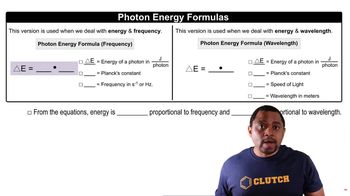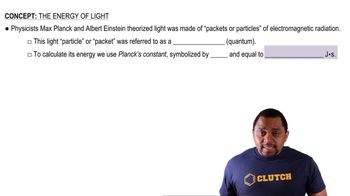Here are the essential concepts you must grasp in order to answer the question correctly.
Photon Energy
The energy of a photon is directly related to its frequency and inversely related to its wavelength. It can be calculated using the equation E = hν, where E is energy, h is Planck's constant (6.626 x 10^-34 J·s), and ν (nu) is the frequency of the radiation. The frequency can be derived from the wavelength using the speed of light equation, c = λν.
Recommended video:
Wavelength and Frequency Relationship
Wavelength (λ) and frequency (ν) are inversely related through the speed of light (c), which is approximately 3.00 x 10^8 m/s. The relationship is expressed as c = λν, meaning that as the wavelength increases, the frequency decreases, and vice versa. This relationship is crucial for converting wavelength measurements into frequency for energy calculations.
Recommended video:
Frequency-Wavelength Relationship
Planck's Constant
Planck's constant is a fundamental constant in quantum mechanics that relates the energy of a photon to its frequency. It has a value of approximately 6.626 x 10^-34 J·s. This constant is essential for calculating photon energy and highlights the quantized nature of electromagnetic radiation, where energy is emitted or absorbed in discrete packets called quanta.
Recommended video:
Photons and Planck's Constant




